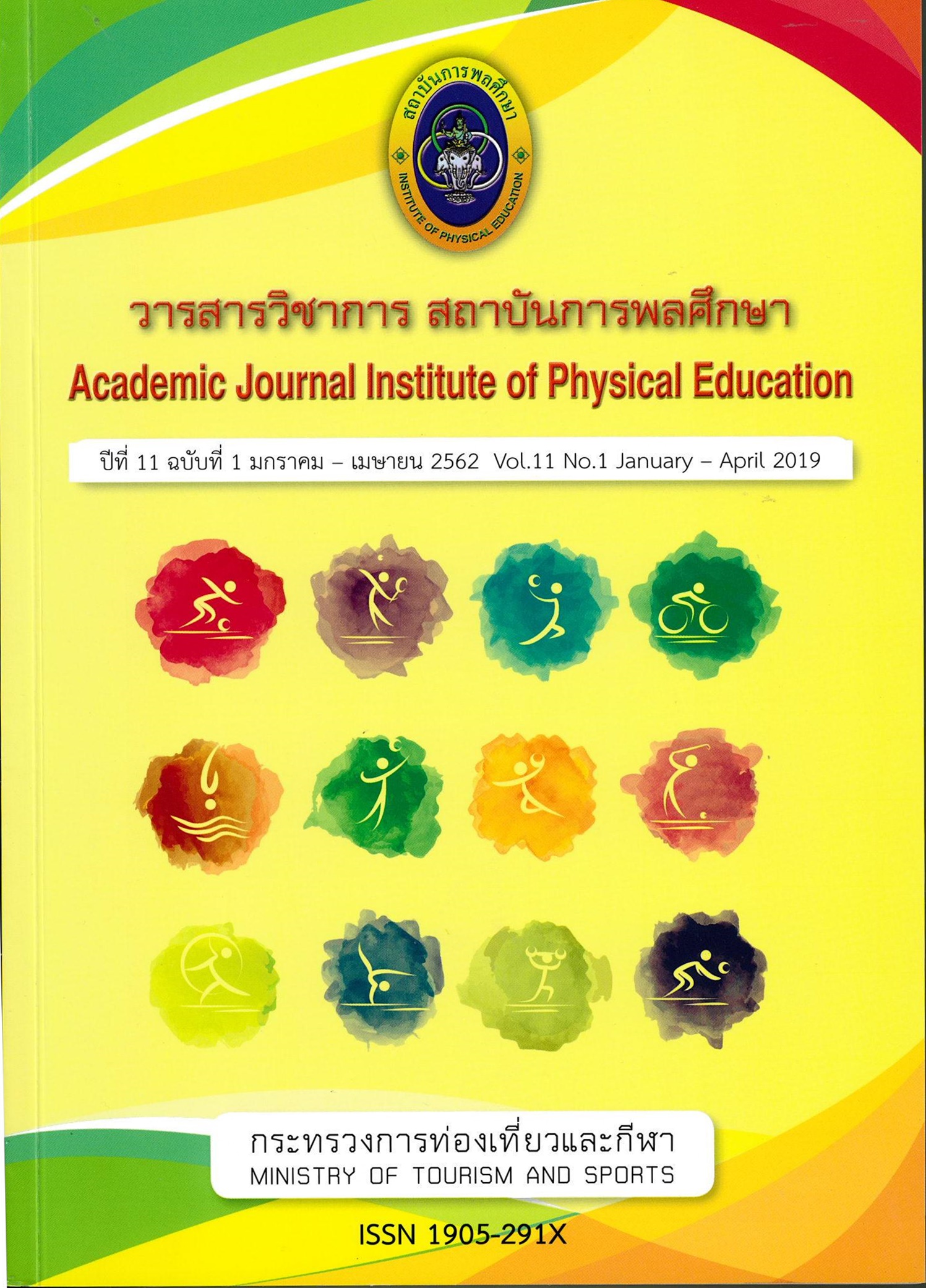DEVELOPMENT OF SPORT TOURISM STRATEGY OF THAILAND
Main Article Content
Abstract
This research aims to 1) study the current situation of sport tourism, 2) analyze the sport tourism situation in Thailand, 3) formulate the sport tourism strategy in Thailand. The research is divided into four phases. The first phase is to study tourism trends and policies regarding to tourism and sport by reviewing document and research paper. Data was analyzed using template analysis. The second phase involves a study of demand and supply which is to understand tourist perception about sport tourism, Data was collected through online and paper-based questionnaire survey – approximately 400 questionnaires have been returned to analyst data, followed by a focus group discussion with 12 experts for more understanding of customer behavior and their perceptions. Phase three is to synthesis data of research phase 1 and phase 2. Prior code from template analysis has been revised and develop a draft of sport tourism strategic plan of Thailand. Phase four is to confirm and support the draft of sport tourist strategic plan of Thailand by 13 experts who are senior management in national level, using Delphi technique.
From pivotal step of research process, 6 strategic issues, 15 strategies and 38 action plans have been presented as a sport tourism strategy of Thailand.
Article Details
The published article is a copyright of the Academic Journal of Thailand National Sports University. The passage appeared in each article in this academic journal is a perspective of each author which is not related to the journal. Each author is required to be responsible for all components of his/her own article. If there are any mistakes, each author must be responsible for those mistakes on his/her own.
References
กระทรวงการท่องเที่ยวและกีฬา. (2559). แผนพัฒนาการกีฬาแห่งชาติ ฉบับที่ 6 (พ.ศ.2560-2564). พิมพ์ครั้งที่ 1. กรุงเทพฯ: สำนักงานกิจการโรงพิมพ์องค์การสงเคราะห์ทหารผ่านศึก.
การกีฬาแห่งประเทศไทย. (2553). แผนยุทธศาสตร์การกีฬาแห่งประเทศไทย (พ.ศ.2560-2564). กรุงเทพฯ : การกีฬาแห่งประเทศไทย.
สำนักงานคณะกรรมการพัฒนาระบบราชการ. (2560). การจัดทำแผนยุทธศาสตร์การพัฒนาหน่วยงาน. สืบค้นเมื่อ 30 เมษายน 2560, จาก http://www.opdc.go.th
สำนักงานปลัดกระทรวงการท่องเที่ยวและกีฬา. (2558). แผนแม่บทเทคโนโลยีสารสนเทศและการสื่อสารของกระทรวงการท่องเที่ยวและกีฬา พ.ศ.2558-2562. สืบค้นเมื่อ 26 กรกฎาคม 2559, จาก http://www.mots.go.th/ewtdl_link.php?nid=7133
สำนักนายกรัฐมนตรี. (2560). แผนงานตามยุทธศาสตร์ชาติระยะ 20 ปี. สืบค้นเมื่อ 20 ธันวาคม 2560 จาก http://www.oic.go.th
สำนักเลขาธิการคณะรัฐมนตรี. (2557). คำแถลงนโยบายของคณะรัฐมนตรี. พลเอก ประยุทธ์ จันทร์โอชา นายกรัฐมนตรี แถลงต่อสภานิติบัญญัติแห่งชาติ. กันยายน 2557. สืบค้นเมื่อ 26 มกราคม 2561, จาก http://www.mfa.go.th/mofa/contents/files/plan-20141016-112823-765038.pdf
Alrawadieh, Z and Johnson, D. (2012). Building Sports Tourism and Event Portfolios – Key Success Factors in Middle East Sports Tourism: A Case Study, London Journal of Tourism, Sport and Creative Industries. 01/2012; 6(7):30-41 Retrieved October 11, 2016, from https://www.vso.cz/pdf/journal-od-tourims_8--7-.pdf
Boote, D.N. & Beile, P. (2005). Scholars before researchers: On the centrality of the dissertation literature review in research preparation. Educational Researcher 34/6, 3-15.
Carr, N. (2006). “A comparison of adolescents’ and parents’ holiday motivations and desires”, Tourism and Hospitality Research, Vol. 6 No. 2, pp. 129-42.
Collis, J. and Hussey, R. (2009). Business research: a practical guide for undergraduate & postgraduate students. New York, Basingstoke : Palgrave Macmillan.
Cornelia Elena Tureac and Turtureanu Anca. (2008). Types and Forms of Tourism. Oeconomica. Nr.1 ACTA Universitatis Danubius.
Creswell, J. W. (2013). Research Design: Qualitative, Quantitative, and Mixed Methods
Approaches. (2nd edition). Thousand Oaks, CA: Sage publications.
Gammon, S. and Robinson, T. (2003). Sport and Tourism: A Conceptual Framework, Journal of Sport Tourism 8(1), pp.21-26.
Giles-Corti, B. and Donovan, R.J. (2002). The relative influence of individual, social and physical environment determinants of physical activity. Social Science & Medicine 54 (2002) 1793-1812.
Gray, D. E. (2004). Doing Research in the Real World. London, SAGE Publications.
Higham, J. (2005). Sport tourism destinations: Issues, opportunities and analysis. London: Elsevier Butterworth-Heinemann.
Hinch T. & Higham J. (2002). Sport Tourism Development: Second Edition. Channel View Publicaitons.
Houston, K. (2013). Supply and demand in tourism. Retrieved October 11, 2016, from http://www.slideshare.net/karenhouston125/supply-and-demand-in-tourism
Hsu, M.H., Ju, T.L., Yen, C.H. and Chang C.M. (2007). Knowledge sharing behavior in virtual communities: the relationship between trust, self-efficacy, and outcome expectations. International Journal of Human-Computer Studies, 65 (2), pp. 153–169.
Inpongpan, WI. (2018). Tourist Expectations and Behaviour towards Sport Tourism in Thailand, St Anne’s College, Oxford, United Kingdom.
Kenrick, D. T., Neuberg, S. L., Griskevicius, V., Becker, D. V., & Schaller, M. (2010). Goal-Driven Cognition and Functional Behavior The Fundamental-Motives Framework. Current Directions in Psychological Science, 19(1), 63-67.
King,A. C. ,Jeffery,R. W. ,Fridinger,F., Dusenbury,L., Provence,S., Hedlund,S. A., and Spangler,K. (1995). Environmental and policy approaches to cardiovascular disease prevention through physical activity: Issues and opportunities. Health Education Quarterly, 22(4),499–511.
Pettigrew, A. M. (1988). The Management of Strategic Change. Oxford, Basil Blackwell.
Saunders, M., Lewis, P. and Thornhill, A. (2009). Research methods for business students. Italy, Pearson Education Limited.
Shonk, D.J. and Chelladurai, P. (2008). Service quality, satisfaction, and intent to return in event sport tourism, Journal of sport management, Vol. 22 Issue 5 pp.587-602.
UK Trade and Investment. (2010). Sport Infrastructure Opportunities in Qatar. London: UK Trade and Investment.
Valek, N.S., Shaw, M. and Bednarik, J. (2014). Socio-demographic characteristics affecting sport tourism choices: A structural model, Acta Gymnica, Vol. 44 no.1, pp.57-65.
Vichit U-on. (2016). “The Literature Review Of The Structural Relationship Model Of Talent Management Effecting On Organizational Performance.” The International Journal of Management, Business and Economics , 1(1), 635.
Weed M.E. (2006). Sports Tourism and the Development of Sports Events, Department of Sport Science, Tourism & Leisure, Canterbury Christ Church University, Retrieved October 11, 2016, UK, from http://www.idrottsforum.org/articles/weed/
Week, M.E. & Bull, C.J. (2004). Sport Tourism: Participant, Policy and Provider. Oxford: Elsevier.
World Tourism Barometer. (2016). International tourist arrival up 4% in the first half of 2016. Retrieved October 11, 2016, from http://media.unwto.org/press-release/2016-09-26/international-tourist-arrivals-4-first-half-2016


